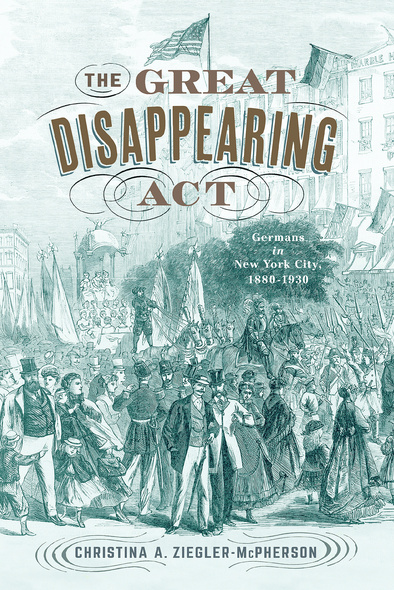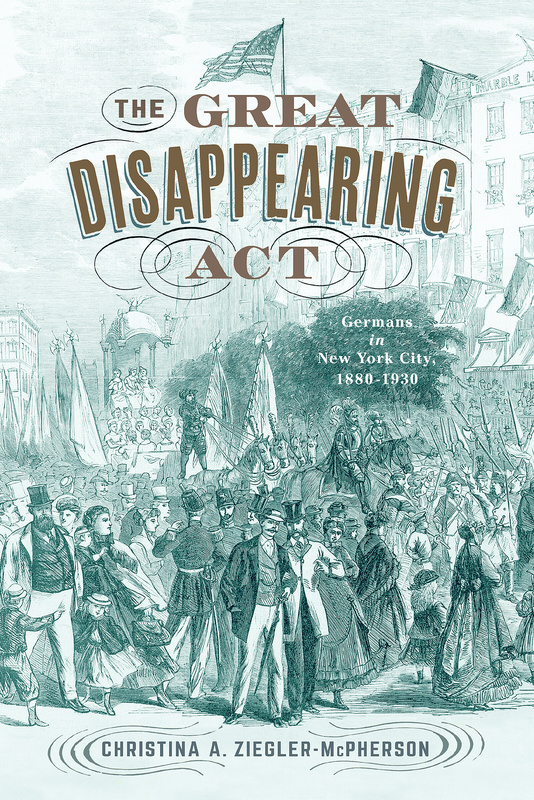
238 pages, 6 x 9
13 b-w illustrations, 9 tables
Paperback
Release Date:10 Dec 2021
ISBN:9781978823181
Hardcover
Release Date:10 Dec 2021
ISBN:9781978823198
The Great Disappearing Act
Germans in New York City, 1880-1930
Rutgers University Press
Where did all the Germans go? How does a community of several hundred thousand people become invisible within a generation?
This study examines these questions in relation to the German immigrant community in New York City between 1880-1930, and seeks to understand how German-American New Yorkers assimilated into the larger American society in the early twentieth century.
By the turn of the twentieth century, New York City was one of the largest German-speaking cities in the world and was home to the largest German community in the United States. This community was socio-economically diverse and increasingly geographically dispersed, as upwardly mobile second and third generation German Americans began moving out of the Lower East Side, the location of America’s first Kleindeutschland (Little Germany), uptown to Yorkville and other neighborhoods. New York’s German American community was already in transition, geographically, socio-economically, and culturally, when the anti-German/One Hundred Percent Americanism of World War I erupted in 1917.
This book examines the structure of New York City’s German community in terms of its maturity, geographic dispersal from the Lower East Side to other neighborhoods, and its ultimate assimilation to the point of invisibility in the 1920s. It argues that when confronted with the anti-German feelings of World War I, German immigrants and German Americans hid their culture – especially their language and their institutions – behind closed doors and sought to make themselves invisible while still existing as a German community.
But becoming invisible did not mean being absorbed into an Anglo-American English-speaking culture and society. Instead, German Americans adopted visible behaviors of a new, more pluralistic American culture that they themselves had helped to create, although by no means dominated. Just as the meaning of “German” changed in this period, so did the meaning of “American” change as well, due to nearly 100 years of German immigration.
This study examines these questions in relation to the German immigrant community in New York City between 1880-1930, and seeks to understand how German-American New Yorkers assimilated into the larger American society in the early twentieth century.
By the turn of the twentieth century, New York City was one of the largest German-speaking cities in the world and was home to the largest German community in the United States. This community was socio-economically diverse and increasingly geographically dispersed, as upwardly mobile second and third generation German Americans began moving out of the Lower East Side, the location of America’s first Kleindeutschland (Little Germany), uptown to Yorkville and other neighborhoods. New York’s German American community was already in transition, geographically, socio-economically, and culturally, when the anti-German/One Hundred Percent Americanism of World War I erupted in 1917.
This book examines the structure of New York City’s German community in terms of its maturity, geographic dispersal from the Lower East Side to other neighborhoods, and its ultimate assimilation to the point of invisibility in the 1920s. It argues that when confronted with the anti-German feelings of World War I, German immigrants and German Americans hid their culture – especially their language and their institutions – behind closed doors and sought to make themselves invisible while still existing as a German community.
But becoming invisible did not mean being absorbed into an Anglo-American English-speaking culture and society. Instead, German Americans adopted visible behaviors of a new, more pluralistic American culture that they themselves had helped to create, although by no means dominated. Just as the meaning of “German” changed in this period, so did the meaning of “American” change as well, due to nearly 100 years of German immigration.
The Great Disappearing Act deals with a major issue in US immigration and ethnic history and focuses on one of the largest urban ethnic concentrations in the US—one which has often gotten far too little consideration in the past. Ziegler- McPherson’s excellent scholarship makes this a thoroughly engaging read that is both important and unique.
The Great Disappearing Act is both an outstanding social history of a leading urban ethnic group and a poignant reminder of the power of external forces to unsettle and undermine the most successful social experiments.
The Great Disappearing Act: An Interview With Christina A. Ziegler-McPherson
In ‘The Great Disappearing Act’, German New York fades into the background,' by Greg Young
Ziegler-Mcpherson’s work provides access to a wealth of research that not only illuminates the rise and fall of a German immigrant community in New York, but also expands our understanding of America’s long history of nativism and aggressive capitalism, and its complex, ever-fraught relationship with 'new' immigrants. And the question of language shift as the primary signifier of integration or assimilation is, of course, one that America faces even today, and deserves further examination.
CHRISTINA ZIEGLER-MCPHERSON is a visiting research scientist at Deutsches Schifffahrtsmuseum (German Maritime Museum) in Bremerhaven, Germany. She is the author of Selling America: Immigration Promotion and the Settlement of the American Continent, 1607-1914.
List of Illustrations
Introduction
1 A Snapshot of Kleindeutschland in 1880
2 Climbing the Economic Ladder in Kleindeutschland in 1880
3 Decades of Change, 1880–1900
4 Disappearing and Remembering: The June 15, 1904, General Slocum Disaster
5 A False Sense of Security, 1904–1914
6 Becoming Invisible: German New Yorkers during World War I
7 The Great Disappearing Act, 1919–1930
Acknowledgments
Notes
Bibliography
Index
Introduction
1 A Snapshot of Kleindeutschland in 1880
2 Climbing the Economic Ladder in Kleindeutschland in 1880
3 Decades of Change, 1880–1900
4 Disappearing and Remembering: The June 15, 1904, General Slocum Disaster
5 A False Sense of Security, 1904–1914
6 Becoming Invisible: German New Yorkers during World War I
7 The Great Disappearing Act, 1919–1930
Acknowledgments
Notes
Bibliography
Index





